小学英语全英教案word版本
2024年新版小学英语教案英文完整版
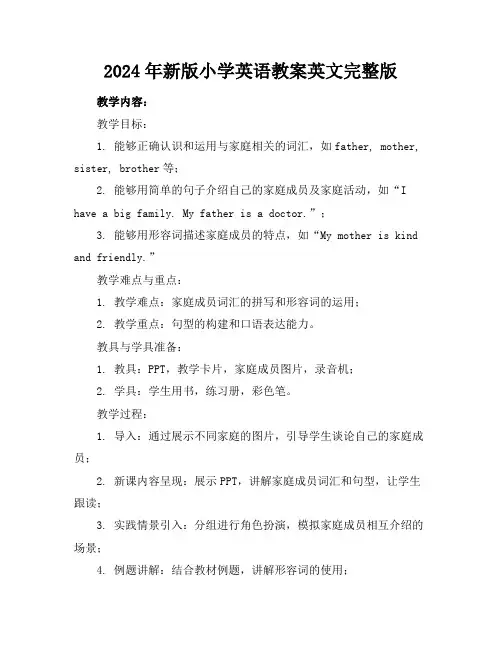
2024年新版小学英语教案英文完整版教学内容:教学目标:1. 能够正确认识和运用与家庭相关的词汇,如father, mother, sister, brother等;2. 能够用简单的句子介绍自己的家庭成员及家庭活动,如“I have a big family. My father is a doctor.”;3. 能够用形容词描述家庭成员的特点,如“My mother is kind and friendly.”教学难点与重点:1. 教学难点:家庭成员词汇的拼写和形容词的运用;2. 教学重点:句型的构建和口语表达能力。
教具与学具准备:1. 教具:PPT,教学卡片,家庭成员图片,录音机;2. 学具:学生用书,练习册,彩色笔。
教学过程:1. 导入:通过展示不同家庭的图片,引导学生谈论自己的家庭成员;2. 新课内容呈现:展示PPT,讲解家庭成员词汇和句型,让学生跟读;3. 实践情景引入:分组进行角色扮演,模拟家庭成员相互介绍的场景;4. 例题讲解:结合教材例题,讲解形容词的使用;5. 随堂练习:让学生用所学的词汇和句型进行口语练习;板书设计:1. My Family;2. 词汇:father, mother, sister, brother, grandpa, grandma等;3. 句型:I have a family. My is a ;4. 形容词:big, small, happy, kind, friendly等。
作业设计:1. 作业题目:请用今天学到的词汇和句型,写一段关于自己家庭的介绍;2. 答案示例:I have a happy family. My father is a doctor. He is very kind. My mother is a teacher. She is friendly to everyone. I also have a younger brother. He is very cute.课后反思及拓展延伸:1. 课后反思:关注学生在课堂上的表现,针对学生的薄弱环节进行针对性指导;2. 拓展延伸:鼓励学生用所学知识,与同学分享更多关于家庭的故事和活动。
小学英语的全英文教案范文
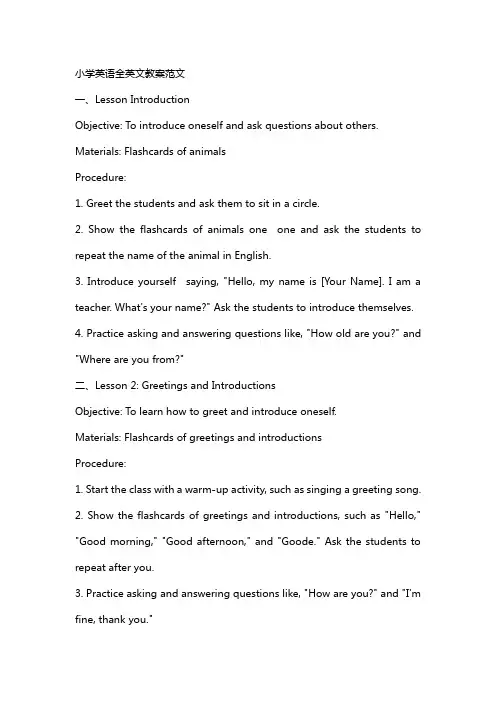
小学英语全英文教案范文一、Lesson IntroductionObjective: To introduce oneself and ask questions about others. Materials: Flashcards of animalsProcedure:1. Greet the students and ask them to sit in a circle.2. Show the flashcards of animals one one and ask the students to repeat the name of the animal in English.3. Introduce yourself saying, "Hello, my name is [Your Name]. I am a teacher. What's your name?" Ask the students to introduce themselves.4. Practice asking and answering questions like, "How old are you?" and "Where are you from?"二、Lesson 2: Greetings and IntroductionsObjective: To learn how to greet and introduce oneself.Materials: Flashcards of greetings and introductionsProcedure:1. Start the class with a warm-up activity, such as singing a greeting song.2. Show the flashcards of greetings and introductions, such as "Hello," "Good morning," "Good afternoon," and "Goode." Ask the students to repeat after you.3. Practice asking and answering questions like, "How are you?" and "I'm fine, thank you."4. Introduce a new student to the class and ask the students to greet and introduce themselves.三、Lesson 3: ColorsObjective: To learn how to name and describe colors in English. Materials: Flashcards of colorsProcedure:1. Start the class showing a colorful picture or object and ask the students to name the colors.2. Show the flashcards of colors one one and ask the students to repeat the color name in English.3. Practice describing colors using phrases like, "It's blue," "It's a red car," and "The sky is blue."4. Draw a colorful picture with the students and ask them to name the colors as you draw.四、Lesson 4: Numbers 1-10Objective: To learn how to count from 1 to 10 in English.Materials: Number flashcards, objects to countProcedure:1. Start the class counting with the students, "One, two, three, four, five." Continue counting up to 10.2. Show the number flashcards one one and ask the students to repeat the number in English.3. Give the students a set of objects, such as counters or toys, and ask them to count the objects using English numbers.4. Play a number game, such as "Simon Says" or "Number Memory," to reinforce the counting skills.五、Lesson 5: AlphabetObjective: To learn the English alphabet and the sounds of each letter. Materials: Alphabet flashcards, letter sounds chartProcedure:1. Start the class singing the "Alphabet Song" to familiarize the students with the English alphabet.2. Show the alphabet flashcards one one and ask the students to repeat the letter name in English.3. Expln the sounds of each letter in the alphabet using a letter sounds chart.4. Practice tracing the letters of the alphabet on a large whiteboard or chart paper, and ask the students to follow along.六、Lesson 6: Family MembersObjective: To learn how to name family members in English. Materials: Flashcards of family membersProcedure:1. Start the class asking the students about their family members in their native language.2. Introduce the concept of family members in English showing the flashcards of family members, such as "mother," "father," "brother," "sister," and "grandparent."3. Practice asking and answering questions about family members, like "Who is your mother?" and "I have a sister."4. Ask the students to bring a picture of their family and describe their family members in English.七、Lesson 7: Dly RoutinesObjective: To learn how to describe dly routines in English. Materials: Flashcards of dly routinesProcedure:1. Start the class discussing the dly routines of the students in their native language.2. Introduce the concept of dly routines in English showing the flashcards of dly routines, such as "wake up," "eat breakfast," "go to school," and "play."3. Practice asking and answering questions about dly routines, like "What do you do in the morning?" and "What do you do after school?"4. Ask the students to role-play their dly routines using English words and phrases.八、Lesson 8: ClothingObjective: To learn how to name and describe different types of clothingin English.Materials: Flashcards of clothingProcedure:1. Start the class discussing the types of clothing worn in different seasons.2. Introduce the concept of clothing in English showing the flashcards of different types of clothing, such as "shirt," "pants," "dress," "sunglasses," and "hat."3. Practice asking and answering questions about clothing, like "What are you wearing today?" and "I am wearing a skirt."4. Ask the students to bring a picture of themselves in different types of clothing and describe their clothing in English.九、Lesson 9: Food and DrinksObjective: To learn how to name and describe different foods and drinks in English.Materials: Flashcards of food and drinksProcedure:1. Start the class discussing the types of food and drinks liked the students.2. Introduce the concept of food and drinks in English showing the flashcards of different food and drink items, such as "apple," "banana," "orange," "milk," and "water."3. Practice asking and answering questions about food and drinks, like "What is your favorite fruit?" and "Can I have some water, please?"4. Ask the students to bring a picture of their favorite food or drink and describe it in English.十、Lesson 10: Review and AssessmentObjective: To review the topics covered in the previous lessons and assess the students' understanding.Materials: Review worksheets, flashcardsProcedure:1. Start the class reviewing the topics covered in the previous lessons, such as greetings, introductions, colors, numbers, family members, dly routines, clothing, food and drinks.2. Conduct a mini-assessment to evaluate the students' understanding asking them to answer questions related to the topics.3. Use flashcards to test the students' vocabulary retention asking them to name the items in English.4. Provide review worksheets for the students to plete, which include exercises like fill in the blanks, match the words with their pictures, and write short sentences using the learned vocabulary.5. Give feedback to the students on their performance and encourage them to continue practicing their English skills.重点和难点解析一、Lesson Introduction重点关注环节:Students' ability to ask and answer questions about themselves.难点解析:This lesson introduces the concept of asking and answering questions about oneself, which is a fundamental skill in language learning. The students may find it challenging to express their personal information accurately and confidently in English.二、Lesson 2: Greetings and Introductions重点关注环节:Students' ability to use greetings and introduce themselves.难点解析:Using proper greetings and introductions is crucial in dly munication. The students might struggle with remembering and applying the correct phrases in different situations.三、Lesson 3: Colors重点关注环节:Students' ability to name and describe colors in English. 难点解析:Naming and describing colors can be challenging for students, especially those whose native language does not use the same color palette as English.四、Lesson 4: Numbers 1-10重点关注环节:Students' ability to count from 1 to 10 in English.难点解析:Counting is a foundational math skill that can be difficult for students to master when learning a new language, as it involvesunderstanding the numerical system and sequencing.五、Lesson 5: Alphabet重点关注环节:Students' ability to recognize and pronounce each letter of the English alphabet.难点解析:The English alphabet may have letters that are not present in the students' native language, making it challenging for them to recognize and pronounce them correctly.六、Lesson 6: Family Members重点关注环节:Students' ability to name family members in English and ask about others'.难点解析:Understanding and using family vocabulary can be emotional and personal for students. They may find it difficult to remember the English words for extended family members or to ask about others' families.七、Lesson 7: Dly Routines重点关注环节:Students' ability to describe their dly routines in English. 难点解析:Describing routines involves sequencing and using past tense verbs, which can be plex for beginners to grasp.八、Lesson 8: Clothing重点关注环节:Students' ability to name and describe different types of clothing in English.难点解析:Clothing terms can be abstract and may not have directtranslations in students' native languages. Additionally, students may be self-conscious about discussing their attire.九、Lesson 9: Food and Drinks重点关注环节:Students' ability to name and describe different foods and drinks in English.难点解析:Food and drink vocabulary can be extensive, and students may have difficulty remembering the names of specific items or describing preferences.十、Lesson 10: Review and Assessment重点关注环节:Students' ability to review and apply the knowledge gned from the previous lessons.难点解析:Assessment can be stressful for students, especially if they feel unprepared. Ensuring that the review is prehensive and allows for individualized learning is crucial.这些教案环节涵盖了从自我介绍到日常生活中的各种主题,每个环节都有其特定的重点和难点。
2024新版小学英语教案英文完整版

2024新版小学英语教案英文完整版一、教学内容本节课选自2024新版小学英语教材第五单元,主题为“Family and Friends”。
具体内容包括:Chapter 1 – Introducing Family Members, Section 1 – Meeting the Family,详细介绍家庭成员的称呼和相关句型。
二、教学目标1. 学生能够听懂、会说、会读家庭成员的英文称呼,如mom, dad, sister, brother等。
2. 学生能够运用所学句型介绍自己的家庭成员。
3. 学生能够通过小组合作,完成关于家庭成员的对话表演。
三、教学难点与重点重点:家庭成员的英文称呼和相关句型的运用。
难点:如何引导学生运用所学知识进行真实场景的对话表演。
四、教具与学具准备1. 教具:PPT、教学卡片、录音机、磁带。
2. 学具:学生用书、练习册、彩色笔。
五、教学过程1. 导入(5分钟)a. 播放一首关于家庭的英文歌曲,引导学生关注家庭主题。
b. 通过提问方式引导学生回顾已学的家庭相关词汇。
2. 新课内容展示(15分钟)a. 教师展示PPT,呈现家庭成员的图片和英文称呼。
b. 教师引导学生跟读,确保发音正确。
c. 教师通过例句展示如何运用所学句型介绍家庭成员。
3. 课堂互动(10分钟)a. 学生两人一组,进行角色扮演,互相介绍家庭成员。
b. 教师巡回指导,纠正发音和语法错误。
4. 例题讲解与随堂练习(10分钟)a. 教师呈现例题,讲解解题思路。
b. 学生独立完成练习,教师提供个别辅导。
5. 小组合作(10分钟)a. 学生四人一组,根据给定场景编写关于家庭成员的对话。
b. 每组进行表演,其他同学进行评价。
a. 教师带领学生回顾本节课所学内容。
b. 学生分享学习心得,教师给予鼓励和指导。
六、板书设计1. Family and Friends2. 主要内容:Family Members: mom, dad, sister, brother, grandpa, grandmaSentence Patterns: This is my , He/She is my七、作业设计1. 作业题目:a. 根据所学内容,介绍自己的家庭成员,不少于5句话。
英文教案小学全英模板
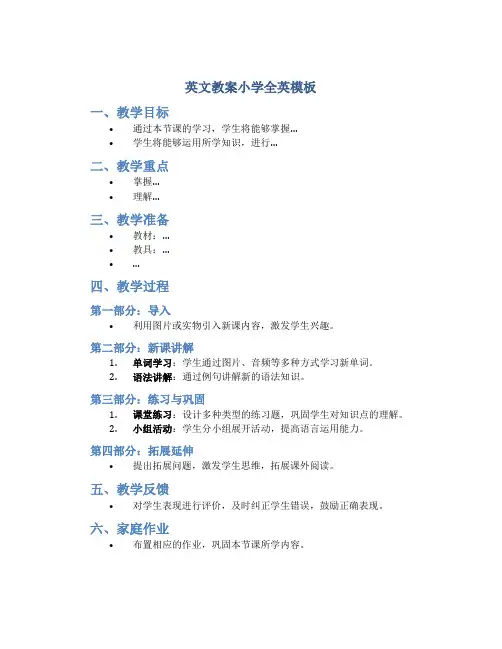
英文教案小学全英模板
一、教学目标
•通过本节课的学习,学生将能够掌握…
•学生将能够运用所学知识,进行…
二、教学重点
•掌握…
•理解…
三、教学准备
•教材:…
•教具:…
•…
四、教学过程
第一部分:导入
•利用图片或实物引入新课内容,激发学生兴趣。
第二部分:新课讲解
1.单词学习:学生通过图片、音频等多种方式学习新单词。
2.语法讲解:通过例句讲解新的语法知识。
第三部分:练习与巩固
1.课堂练习:设计多种类型的练习题,巩固学生对知识点的理解。
2.小组活动:学生分小组展开活动,提高语言运用能力。
第四部分:拓展延伸
•提出拓展问题,激发学生思维,拓展课外阅读。
五、教学反馈
•对学生表现进行评价,及时纠正学生错误,鼓励正确表现。
六、家庭作业
•布置相应的作业,巩固本节课所学内容。
七、教后反思
•总结本节课教学过程,查找不足并设想改进方法。
这个教案模板旨在帮助老师规划和设计一堂全英文的小学英语课程,灵活运用各种教学方法,提高学生的学习兴趣和语言运用能力。
希望能为您的英语教学提供一定的参考价值。
小学英语全英教案模板
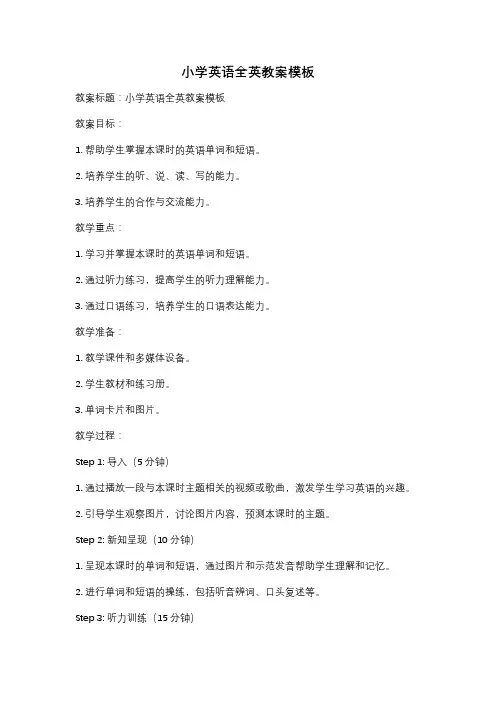
小学英语全英教案模板教案标题:小学英语全英教案模板教案目标:1. 帮助学生掌握本课时的英语单词和短语。
2. 培养学生的听、说、读、写的能力。
3. 培养学生的合作与交流能力。
教学重点:1. 学习并掌握本课时的英语单词和短语。
2. 通过听力练习,提高学生的听力理解能力。
3. 通过口语练习,培养学生的口语表达能力。
教学准备:1. 教学课件和多媒体设备。
2. 学生教材和练习册。
3. 单词卡片和图片。
教学过程:Step 1: 导入(5分钟)1. 通过播放一段与本课时主题相关的视频或歌曲,激发学生学习英语的兴趣。
2. 引导学生观察图片,讨论图片内容,预测本课时的主题。
Step 2: 新知呈现(10分钟)1. 呈现本课时的单词和短语,通过图片和示范发音帮助学生理解和记忆。
2. 进行单词和短语的操练,包括听音辨词、口头复述等。
Step 3: 听力训练(15分钟)1. 播放录音,让学生听对话或短文,回答相关问题。
2. 播放录音,让学生跟读对话或短文,注意语音语调的模仿。
Step 4: 口语练习(15分钟)1. 分组进行对话练习,学生根据提示卡片进行对话。
2. 教师巡回指导,纠正学生的发音和语法错误。
Step 5: 读写训练(15分钟)1. 学生个别或小组朗读课文,注意语音语调和流利度。
2. 学生完成练习册上的相关练习,巩固所学内容。
Step 6: 拓展活动(10分钟)1. 学生自由发挥,用所学内容编写简短的对话或小故事。
2. 学生进行角色扮演,展示自己的创造力和口语表达能力。
Step 7: 总结与评价(5分钟)1. 教师对本课时的学习内容进行总结,并强调重点和难点。
2. 学生进行自我评价,反思自己在本课时中的表现和收获。
教学延伸:1. 布置相关的家庭作业,巩固本课时的学习内容。
2. 鼓励学生积极参与英语角、英语俱乐部等英语学习活动。
教学反思:本教案通过多种教学方法和活动形式,全面培养学生的听、说、读、写能力。
同时,通过合作和交流活动,激发学生的学习兴趣和积极性。
英语教案模板小学全英
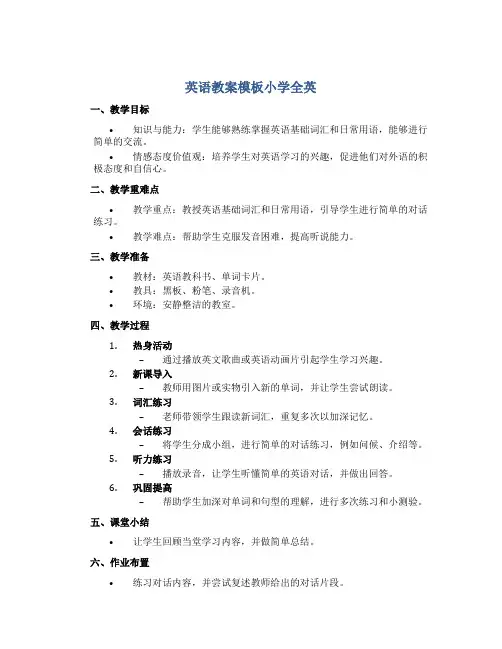
英语教案模板小学全英
一、教学目标
•知识与能力:学生能够熟练掌握英语基础词汇和日常用语,能够进行简单的交流。
•情感态度价值观:培养学生对英语学习的兴趣,促进他们对外语的积极态度和自信心。
二、教学重难点
•教学重点:教授英语基础词汇和日常用语,引导学生进行简单的对话练习。
•教学难点:帮助学生克服发音困难,提高听说能力。
三、教学准备
•教材:英语教科书、单词卡片。
•教具:黑板、粉笔、录音机。
•环境:安静整洁的教室。
四、教学过程
1.热身活动
–通过播放英文歌曲或英语动画片引起学生学习兴趣。
2.新课导入
–教师用图片或实物引入新的单词,并让学生尝试朗读。
3.词汇练习
–老师带领学生跟读新词汇,重复多次以加深记忆。
4.会话练习
–将学生分成小组,进行简单的对话练习,例如问候、介绍等。
5.听力练习
–播放录音,让学生听懂简单的英语对话,并做出回答。
6.巩固提高
–帮助学生加深对单词和句型的理解,进行多次练习和小测验。
五、课堂小结
•让学生回顾当堂学习内容,并做简单总结。
六、作业布置
•练习对话内容,并尝试复述教师给出的对话片段。
七、课后反思
•教师对本节课的教学进行总结和反思,为下节课做好准备。
以上为英语教案模板,建议老师根据具体情况进行适当调整,以促进学生的英语学习效果。
小学英语教案模板英文版
小学英语教案模板英文版教案小学英语教案模板英文版教学目标:1. 学生能够掌握本节课所学的单词和句型。
2. 学生能够运用所学单词和句型进行简单的对话。
3. 学生能够通过活动提高英语听、说、读、写能力。
教学重点:1. 掌握单词:apple, banana, orange, pear, grape2. 掌握句型:What’s this? It’s an apple. I like apples.教学难点:1. 学会正确发音和拼写单词。
2. 学会运用句型进行对话。
教学准备:1. 单词卡片:apple, banana, orange, pear, grape2. 图片:apple, banana, orange, pear, grape3. 教学课件教学过程:一、热身活动(5分钟)1. 歌曲导入:播放一首关于水果的歌曲,如《Fruit Salad》。
2. 舞蹈动作:引导学生跟随歌曲做简单的舞蹈动作,活跃课堂气氛。
二、新授环节(15分钟)1. 教师展示单词卡片,带领学生跟读单词:apple, banana, orange, pear, grape。
2. 教师展示图片,引导学生说出对应的单词。
3. 教师教授句型:What’s this? It’s an apple. I like apples。
4. 学生跟读句型,教师纠正发音。
三、互动环节(15分钟)1. 小组活动:将学生分成若干小组,每组发放一套单词卡片和图片。
2. 学生在小组内进行对话练习,一人问:“What’s this?”,另一人回答:“It’s an apple. I like apples.”。
3. 教师巡视,纠正发音和句型错误。
四、游戏环节(10分钟)1. 猜水果游戏:教师将水果图片贴在黑板上,让学生闭上眼睛,随机拿掉一张图片,学生猜猜哪个水果被拿掉了。
2. 学生回答:“I think it’s anapple/banana/orange/pear/grape.”3. 教师揭示答案,并给予鼓励和表扬。
小学英语全英教案(17篇)
小学英语全英教案(17篇)篇1:全英教案篇5:小学英语全英说课稿篇9:小学英语全英说课稿篇10:小学英语全英说课稿I’ll finish this lesson in five steps。
step1 lead--in activitiesI will begin my class with “drawing and guessing” game,just like this : I show students some vehicles such as bike ,bus ,jeep which they learned before by “Stick Figures” and ask them guess what’s it。
Purpose: It is important to form a better English learning surrounding for the Ss by guessing game。
and at the same time it provides situations to review learned knowledge for the next step。
step2 prestentationNow I’ll mainly talk about this step。
1、first there is a Free talk between T and Ss。
For example: I show many pictures of beautiful cities and ask students some questions,such as “do you like this city?where do you want to go ?”and help Ss to answer them with “by train ,by plane,by ship”。
小学英语教学目标全英教案模板(共3篇)
小学英语教学目标全英教案模板(共3篇)第1篇:小学英语全英教案小学英语全英教案范文【篇1:全英文英语教案模板】leon plannsefc module2 unit reading in teacher: period:period1 type:reading duration: 45minutes teaching ideologythe current theory view reading as a interactive proce which involves not only the printed page but also the reader’s old knowledge of the language in general, the world and the text types.in the reading proce, these factors interact with each other and compensate for each other.based on the understanding of reading as an interactive proce, teaching reading in the claroom is divided into three stages in which the top-down and bottom-up techniques integrated to develop the students language efficiency in general and reading strategies.the three stages are pre-reading, while-reading and post-reading.teaching material and learning condition the analysis of teaching material the teaching material is the reading part from nsefc module2 unit.the topic of this unit is.this paage mainly introduces the paage consists of paragraphs.the first paragraph is a general introduction of the.para.2 to para.4 introduces.the last paragraph tells about.the topic is not new to the.but there is some new words and phases in the paage.the analysis of learning condition the students are from grade1 in senior high school.as high school students, they have achieved certain english level and they have the ability to get the basic idea of the reading.since they are in grade1, they are easily activated and want to air their own opinions on the topic.they are familiar with the topic of andknow some.but they may not know before.moreover, their vocabulary is limited so they may have difficulties in understanding some sentences.learning objectives nguage skills ? at the beginning of the cla, can predict the content of the paage based on the title.? can scan the paage and find out the specific information such as the person related withcan summarize the paage with the help of the clues of the nguage knowledgecan master the key words and phrases of the paage as follows,.? can learn , especially 3.affectswill realize that and they will concern themselves with the iue of4.cultural awarenewill broaden their minds by knowing something about 5.learning strategieswill cultivate their ability individual learning and cooperative learning by doing someactivities independently and some in groups.? will communicate with each other in english while doing the group nguage difficultiesfocuses and anticipated language focusesthis is a reading period so the focus is to cultivate the students’ reading skills.the many activities are designed to help to train their reading skills, such as predicting, skimming, scanning and summarizing.it is also important for the to master the new words and phrases.anticipated difficultiesas the have a limited vocabulary, so they may have some difficulties in understanding the paage.so the teacher will help them learn the new words and phrases.may did not heard before, so the teacher will tell them some background knowledge aboutit.teaching methodthree-stage model: based on the understanding of reading as an interactive proce, teaching reading in the claroom is divided into three stages in which the top-down and bottom-up techniques integrated to develop the students language efficiency in general and reading strategies.the three stages are pre-reading, while-reading and post-reading.teaching aids multimedia devices and ppt documents: in order to help to fully understand the whole paage, i adopt multimedia devices and ppt documents to bring the real-life situation into the claroom.teaching procedures step1.lead-in(6min)activity1.greetings and free-talking(2min)t leads into the topic by asking some they know.tell the name of the they know freely.t: hello boys and girls.(say hello to the teacher.)t: when we say , what appears in your minds?(tell the things appear in their minds freely.)t: what are the ?(tell some names of.) activity2.picture-talking(4min)t shows some pictures about the in china and abroad.after seeing the pictures, are expected to tell the similarities of them.t: just now, you talk about some in china.now, let’s see some pictures of some.(t shows the pictures and see them carefully.) t: what do the have in common?for example, they are very precious.what are your opinions?(t gives them some hints and tell the characteristics of)[aims] in this step, t first leads in the topic by talking with the freely about the whichis familiar to them and then see some pictures and tell the characteristics.these two activities aim to arouse the ’ interests in the topic and activate their old knowledge of.then will bementally prepared for the reading comprehension.what’s more,when they are talking about the charateristics of, they will realize that theare rare and precious and they will concern themselves with the iue of.step2.pre-reading(3min)activity1.knowing something about(1min)t gives a brief introduction of the.will know the t: today, we are going to learn.it is.do you know what is?(t shows some pictures ofand get to know the.)activity2.predicting(2min)t asks to read the title of the paage and then ask them some questions.will predict the content of the paage with the help of the title.t: please look at the ti tle “”, what does “” mean?(if the can not give the answer, then t explain it.)t: in search means that people are looking for it.why are people looking for it? can you gue? what will the paage talk about?(predict the content, but t will not give the answer here.)[aims] in this step, the first know some information of the;the background information will make it easier for the to understand the paage.then t asks to make predictions about the paage.it aims to help develop the reading skills of predicting.step3.while-reading(22min)activity1.skimming(4min)skim the whole paage and find out and check their predictions.t: why are people still ? here is a multiple choice for you.activity2.scanning(3min)t presents several true or false statements and asks the to scan the paage and judge the right from the wrong.(keys: F,F,T,T,F)activity3 close-reading(15min)t designs various kinds of activities and do the activities to fully understand the paage.para.1t: please read para.1 carefully and then take some note aboutthe.para.2-4please read para.2-4 carefully and then find out the removal of the room.please read para.2-4 carefully and then find out the person related with the amber room and the things them down with it.para.5 please read para.5 carefully and then find out the the rebuilding of the amber room.【篇2:pep小学英语全英教案模板】the english teaching plan of pep book 4enhe primary school teacher:___________ the curriculum schedule cla:____________ cla:____________ the teaching schedule the students’ result tablethe english curriculum standard英语课程标准一级目标总体目标:对英语有好奇心,喜欢听他人说英语;能根据教师的简单指令做游戏、做动作、做事情(如涂颜色、连线);能做简单的角色扮演;能唱简单的英文歌曲,说简单的英语歌谣;能在图片的帮助下听懂和读懂简单的小故事;能交流简单的个人信息,表达简单的情感和感觉;能书写字母和单词;对英语学习中接触的外国文化习俗感兴趣。
小学英语全英教案模板-小学全英文教案模板
小学英语全英教案模板
一、教学目标
知识目标
•通过本节课的学习,学生能够掌握新单词和词组。
•学生能够正确运用本课所学内容进行口语表达和书面表达。
能力目标
•提高学生的听、说、读、写能力。
•培养学生的语言交际能力和合作精神。
情感目标
•培养学生的学习兴趣,激发学习英语的热情。
•培养学生的自学和合作学习意识。
二、教学重点
•学习新单词和词组。
•提高学生的口语表达能力。
三、教学难点
•学会正确运用新单词进行句子的构造。
四、教学准备
•教师:准备教案、教具、课件等。
•学生:准备学习用书、笔、纸等。
五、教学过程
1. Warm-up(热身活动)
在黑板上画出几个单词的图片,让学生通过图片猜测单词意思。
2. Presentation(呈现新知识)
教师展示新单词和词组,让学生跟读学习。
3. Practice(练习)
教师设计口语练习环节,让学生两两进行对话练习,加深对新单词的记忆。
4. Production(表达)
要求学生运用新学的单词和词组进行句子编写,展示个人观点。
5. Homework(作业布置)
布置相关作业,巩固所学内容。
六、教学反思
经过本节课的教学,学生对新单词的掌握情况如何?口语表达能力有所提高吗?如何改进教学方式提高学生的学习兴趣?
这份全英文教案模板力求通过多种学习方式和环节的设计,引导学生在轻松愉
悦的氛围中学习英语,培养其语言交际能力和合作精神,为日后的学习打下坚实的基础。
- 1、下载文档前请自行甄别文档内容的完整性,平台不提供额外的编辑、内容补充、找答案等附加服务。
- 2、"仅部分预览"的文档,不可在线预览部分如存在完整性等问题,可反馈申请退款(可完整预览的文档不适用该条件!)。
- 3、如文档侵犯您的权益,请联系客服反馈,我们会尽快为您处理(人工客服工作时间:9:00-18:30)。
小学英语全英教案
Teaching Plan
----外*** ***
Teacher: *****
Content: Lesson 14 Unit7 colors (2)
1. Knowledge aim
①The text of lesson 14 is talk about colors.
②Understand and speak out the nine new words: blue, pink, black, white, have, pet, it, rabbit.
③Study the new sentences: “what color is it?”“I have a…” “It’s…” (The answer is color)
2. Teaching aim
①Master the new words.
②Make sentences with the new words.
③Let the students to the color of interrelated inquiries and responses have a clear understanding.
④Develop students’ imaginations.
3. Develop teaching point.
①Speak out the new words and make sentences in right tone.
②Stress the “a” is important to the sentence “I have a….” Many students often miss it.
4. Teaching aids
Cards, tape, some stars (To encourage students)
5. Activity conception: Group-works, TPR
6. Teaching steps.
Step 1: arming up
①Introduce myself then to greet.
②Let all students stand up and chant a poem with action. (The poem is “Stop Wait Go”, This is the content of last class).
Step2: Reviewing and leading in
①Show four cards of “red, yellow, green, orange” on the blackboard then let students read it.
②Teacher wants to play a game called “Where is it.” The rule of game shows on PPT (对上节课单词的检测)
③After reviewing the words, teacher ask student a question: There are many colors in our life, now who can try to say the other colors?
④Teacher show the four cards of “blue”, “pink,”“black,”“white” on the blackboard. Read them follow teacher and let students show their fingers to spell them.
⑤Show the PPT about the colors. And let students talk about the colors that we can see in our life.
⑥Ask another question: “Now most of people fed animal, what the animal called?
⑦Teach say the right answer and show another card of “pet”. Students read it follow teacher.
⑧Show PPT about “rabbit” on the blackboard and let student read it.
⑨At this moment, students need rest. So teacher play a game about new words . Teacher show the Chinese, students say it in English.
Step 3: Learn new lesson
①Firstly, listen to the tape about the new lesson.
②Put three cards of “it”, “have”, “color” and let students read follow teacher.
③Secondly, open the book on page 65 and read the text together.
④Thirdly ask students read.
⑤Underline the stress and translate the dialogue.
⑥Stress the sentence of “What color is it?”“I have a….”and the answer of “It’s….” (The answer must about color)
Step 4: Set up situation
①Show the PPT about different colors’ things and ask some student to act.
②Ask more students to act.
③At last, whole class read the text once more.
Step 5: Summary
Today, we learn some basic knowledge of colors. I hope you can have a consciousness about it. You have to review, recite words and do to homework. Step 6: Homework
①Copy the text and new words. ( Three times.)
②Recite the dialogue and words.。
